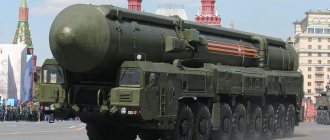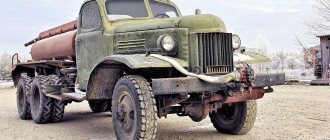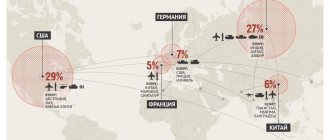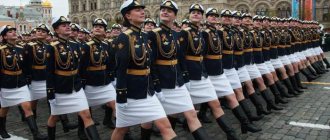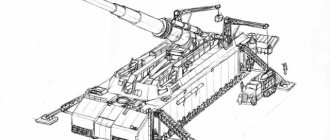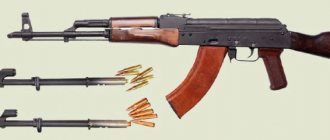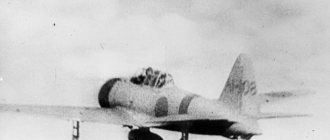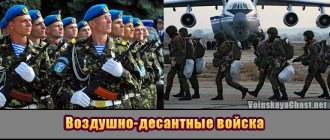The Russian Federation, as the legal successor of the collapsed Soviet Union, is today considered by many European states as a potential adversary. Therefore, when creating military doctrines, the emphasis is on possible military confrontation. The doctrine of the United States of America is somewhat different. According to experts, of all states, it is the United States that strives for global domination. The Russian Federation is forced to respond symmetrically. In this regard, it is quite understandable why many compare the military equipment of the United States and Russia. According to experts, the military potential of the two states is not inferior to each other. Information about Russian weapons and military equipment is contained in the article.
Acquaintance
The formation of the armed forces of the Russian Federation took place in 1992. At that time, only 288,000 people were in the Armed Forces. Today the number has reached 1 million. According to experts, Russia’s military equipment is modern and very developed. The country has weapons of mass destruction and many nuclear stockpiles. According to experts, the Russian army does not use weapons brought from abroad. Everything necessary for the needs of the army is manufactured on the territory of the state. Gunsmiths and the defense industry are developing new military equipment in Russia. Today, the aircraft is equipped with the most modern weapons. Modernizing the army, the state had to spend more than 19 trillion rubles. Experts suggest that by 2022, samples of new military equipment from Russia will account for at least 70%.
Message “Modern equipment of the armed forces of the Russian Federation”
The Armed Forces of the Russian Federation were
formed in 1992. At the time of creation, their number was 2,880,000 people. Today it reaches 1,000,000 people. Not only is it one of the largest armed forces in the world. The armament of the Russian army today is very modern, developed, has reserves of nuclear weapons, weapons of mass destruction, a developed system for countering enemy attacks and redeploying weapons if necessary. The army of the Russian Federation practically does not use foreign-made weapons. Everything needed is manufactured in the country. All military equipment and weapons are the result of research by scientists and the functioning of the defense industry. The army is governed by the Ministry of Defense of the Russian Federation through military districts and other governing bodies. Also, a General Staff has been created to manage the Russian Armed Forces, whose tasks are defense planning, conducting mobilization and operational training, organizing reconnaissance operations, etc.
Armored vehicles
Military equipment and weapons of the Russian army are constantly being modernized. This happens with vehicles such as armored personnel carriers, infantry fighting vehicles and infantry fighting vehicles. They are intended for combat operations on various types of terrain, and are also capable of transporting a combat detachment of up to 10 people and overcoming water obstacles. These vehicles can travel both forward and backward at the same speed.
Thus, at the beginning of 2013, the BTR-82 and BTR-82A entered service with the Russian army. This modification has an economical diesel generator set and is equipped with an electric drive with a stabilizer for controlling the gun and a laser sight. The designers improved reconnaissance capabilities, and the fire extinguishing and fragmentation protection systems were improved. There are about 500 BMP-3s in service. This equipment and the weapons with which it is equipped have no equal in the whole world. Infantry fighting vehicles are equipped with mine protection, have a durable and sealed body, providing all-round armor to protect personnel. The BMP-3 is an air transportable amphibious vehicle. On a flat road it reaches speeds of up to 70 km/h.
Russian nuclear weapons
Nuclear weapons have been adopted since the times of the USSR. This is a whole complex that includes ammunition itself, carriers and means of transportation, as well as control systems. The action of the weapon is based on nuclear energy, which is released during the fission or fusion reaction of nuclei. Russia's new nuclear weapon today is the RS-24 Yars. Development on it began under the USSR in 1989. After Ukraine refused to develop it jointly with Russia, all design developments were transferred to MIT in 1992. The design of the Yars rocket is similar to the Topol-M. Its difference is a new platform for breeding blocks. The Yars has an increased payload, and the hull is treated with a special compound to reduce the impact of a nuclear explosion. This missile is capable of performing programmed maneuvers and is equipped with a complex to counter missile defense systems.
Pistols
Pistols in troops of any kind are used for close combat and personal self-defense. This weapon became widespread due to its compactness and light weight, but the main advantage was the ability to fire with one hand. Until 2012, pistols in service with the Russian army were mainly used by Makarov systems (PM and PMM). The models are designed for 9 mm cartridges. The firing range reached 50 meters, the rate of fire was 30 rounds per minute. Magazine capacity: PM - 8 rounds, PMM - 12 rounds. However, the Makarov pistol is recognized as obsolete, and a more modern model has been adopted. This is “Strizh”, developed jointly with members of special forces. In terms of its technical characteristics, the pistol surpasses the world famous Glock. Another pistol that the army of new Russia adopted in 2003 was the SPS (Serdyukov self-loading pistol).
9-mm cartridges with small ricochet bullets, as well as armor-piercing and armor-piercing tracer bullets were developed for it. It is equipped with a special spring to speed up the change of the double-stack magazine and two safety valves.
Aviation
The armament of the Russian Army in terms of aviation allows it to provide protection and attack on the enemy, as well as carry out various operations, such as reconnaissance, security and others. Aviation is represented by airplanes and helicopters for various purposes. Among the aircraft, it is worth noting the Su-35S model. This fighter is multifunctional and highly maneuverable; it is designed to strike moving and stationary ground targets. But its main task is to gain air supremacy. The Su-35S has engines with higher thrust and a rotary thrust vector (product 117-S). It uses fundamentally new on-board equipment - the aircraft’s information and control system ensures the maximum degree of interaction between the pilots and the aircraft. The fighter is equipped with the latest Irbis-E weapons control system. It is capable of simultaneously detecting up to 30 air targets, firing at up to 8 targets without interrupting observation of ground and air space. Among helicopters, the KA-50 “Black Shark” is the modern weapon of the Russian army. These two combat vehicles are formidable weapons; so far no country in the world has been able to create and oppose equipment that matches them in terms of tactical and technical capabilities. "Alligator" can operate at any time of the day or night, under any weather and climatic conditions. The “Black Shark” is designed to destroy various armored vehicles, including tanks, as well as to provide protection for ground facilities and troops from enemy attacks.
Vehicles
The Russian army is equipped with vehicles for various purposes on a large scale. Automotive vehicles are presented in the form of highly mobile, cargo-passenger, multi-purpose, specially protected and armored vehicles. The Tiger STS, which was adopted by the Russian army, has proven itself especially well. The vehicle is used for reconnaissance operations, monitoring the enemy, transporting personnel and ammunition, patrolling high-risk areas, and escorting mobile columns. It has high maneuverability, a large range, and good visibility for firing.
For the rapid transfer of equipment, ammunition and personnel in large quantities, the KRAZ-5233BE “Spetsnaz” is used. The vehicle is designed for work in harsh climatic conditions (from - 50 to + 60 degrees), has high cross-country ability - it can overcome water obstacles up to 1.5 m deep and snow covers up to 60 cm high.
Tanks
Tanks are armored fighting vehicles and are used by ground troops. Today, the Russian Army uses the T-90, T-80 and T-72 models. Modern tank armament outnumbers that of the United States Army. The T-80 has been supplied to the army since 1976, since then it has undergone several modifications. It is used to support ground forces with firepower, destroy people and various objects (for example, fortified firing points), and to create defensive lines. It has multi-layer armor and increased maneuverability. Equipped with a 125-mm cannon coaxial with a machine gun, a Utes machine-gun complex, a smoke grenade launch system, as well as an anti-tank missile control system.
The T-90 tank, especially the T-90SM modification, can be safely positioned as the latest weapon of the Russian army. Equipped with an improved fire extinguishing system, an air conditioning system has been added, and it is possible to hit moving targets with high accuracy while moving. In all respects it surpasses tanks such as the Abrams or Leopard.
The T-14 is the first tank in the world to implement in its design concept the concept of “network-centric warfare”, where the T-14 is used primarily as a reconnaissance, target designation and fire adjustment vehicle for self-propelled guns, air defense systems and T-90 tanks accompanying its tactical unit . For this purpose, the T-14 has a circular Doppler radar with a medium-range APAA[8], ultraviolet HD surveillance cameras with 360° circular coverage, capable of detecting the operation of vehicle engines by exhaust from ionized gas[9]. The tank is also capable of launching the Pterodactyl unmanned reconnaissance and target designation vehicle with its own surveillance radar and infrared sight. The T-14 is a “stealth tank” with a radical reduction in visibility in the infrared, radio and magnetic range, which reduces the target acquisition distance of the seeker of the ATGM “Javelin”, “Spike” or “Brimstone” and similar ones by 2.7 times, even without the use of aerosols by the tank
Machine guns in service with the army
The most famous weapon of the Russian army is the Kalashnikov assault rifle. And although they do not have grace or beauty, they have earned popularity for their simplicity and ease of use. This machine gun dates back to 1959, when it was first adopted by the USSR army. In recent years, starting from 1990, AK-74M 5.45 caliber models with a rail for mounting various types of sights have been produced for the army. In it, the designers were able to realize the dream of a universal machine gun. But no matter how universal it may be, history does not stand still, and technology develops.
Today, the modern weapons of the Russian army in terms of machine guns are represented by the AK-12 model. It does not have the disadvantages of all types of AKs - there is no gap between the receiver cover and the receiver itself. The design makes the machine convenient for use by both right-handers and left-handers. The model is compatible with magazines for AKM and AK-74. It is possible to mount an under-barrel grenade launcher and various types of sights. The shooting accuracy is almost 1.5 times higher than that of the AK-74.
Grenade launchers in Russian troops
Grenade launchers are designed for various purposes and are divided into several types. Thus, they distinguish easel, automatic, manual, multi-purpose, under-barrel and remote-controlled. Depending on the type, they are intended to destroy enemy troops, moving and stationary targets, and to destroy unarmored, lightly armored and armored vehicles. New small arms of the Russian army in this category are represented by the RPG-30 “Hook” grenade launcher. It is a disposable weapon and entered service with the troops in 2013. The anti-tank system is double-barreled and contains two grenades: an simulator and a 105-mm combat grenade.
The simulator ensures the activation of the enemy’s defense functions, and the combat grenade directly destroys the target that remains unprotected.
We cannot ignore such modern weapons of the Russian army as the GP-25 and GP-30 under-barrel grenade launchers. They are equipped with Kalashnikov assault rifles of the AK-12, AKM, AKMS, AKS-74U, AK-74, AK-74M, AK-103 and AK-101 modifications. The GP-25 and GP-30 underbarrel grenade launchers are designed to destroy living and non-living targets and unarmored vehicles. The target firing range is about 400 m, the caliber is 40 mm.
Naval forces
Russia The naval armament used by the army of the new Russia is quite diverse. Surface ships provide support for submarine forces, transport landing troops and cover landings, protect territorial waters, the coastline, search and track the enemy, and support sabotage operations. Submarine forces provide reconnaissance operations and surprise attacks on continental and maritime targets. Naval aviation forces are used to attack enemy surface forces, destroy key facilities on its coastline, and intercept and prevent enemy air attacks.
The Navy includes destroyers, patrol ships of the far and near sea zones, small missile and anti-submarine ships, missile, anti-sabotage boats, large and small landing ships, nuclear submarines, minesweepers, and landing boats.
Defense production After the collapse of the USSR, the defense industry experienced a sharp decline. However, in 2006, Russian President Vladimir Putin approved the State Arms Development Program for 2007-2015. According to this document, over the specified years, new weapons and various technical means should be developed to replace the old one. The development and supply of new and modernized weapons and equipment is carried out by such enterprises as Russian Technologies, Oboronprom, Motorostroitel, Izhevsk Machine-Building, JSC Russian Helicopters, Uralvagon and others. Most research centers and design bureaus developing weapons for the Russian army are strictly classified, as are defense industry enterprises. But the defense industry today provides jobs for many large and medium-sized cities of the Russian Federation.
About heavy weapons
According to experts, Russia is four times superior to the United States in the production of self-propelled artillery multiple launch rocket systems. The Russian army has weapons that have no analogues in Western countries and, according to experts, will not appear in the near future. For example, the Russian Federation has the Solntsepek heavy flamethrower system and the Tornado multiple rocket launcher system. In Russia, the names given to military equipment are quite original. For example, in Great Britain a self-propelled artillery unit is listed as “Archer”, an American howitzer is listed as “Paladin”. In Russia, the flower names used for self-propelled howitzers, mortars and cannons are: “Carnation”, “Acacia”, “Tulip”, “Hyacinth”, “Peony”. The names “Malyutka” and “Chrysanthemum” were used for the 9M14M and 9M123 anti-tank missiles.
Name of Russian weapons according to NATO classification
The purpose of a particular object is indicated by the initial letter. For example: F (fighters), S (surface-to-surface missiles), SS (ballistic missiles). It is worth noting that names with two syllables indicate the reactive nature of the action, and with one - piston parameters. If any system is not provided for in the adopted table, a new one is invented for it or it is classified in the “M” category (for military aircraft).
In the USSR and Russia, combat aviation did not receive official second names. For example, the American F-15 fighter could be indicated according to documentation as “Eagle”. The Russian MiG-29 was simultaneously and unofficially called “Rook”. Typically, Soviet pilots did not use NATO terms, since they were either unknown, or it was more common to hear the unofficial nickname of the combat vehicle.
Often the names of Russian weapons in Western terminology sounded offensive, especially during the Cold War. For example:
- The Mig-15 was called differently - Falcon ("Falcon"), Fagot (a bundle of firewood or a homosexual).
- Mig-29 – Fulcrum (fulcrum).
- Tu-95 – Bear (bear).
- Tu-22M - Backfire (return or return fire).
Transport aircraft were designated by the letter “C”. Accordingly, nicknames began with her: Careless (careless), Candid (sincere). This feature is due to the fact that the names were given in alphabetical order.
"Voevoda"
The main defense of the state is provided by nuclear strategic weapons. It is represented by a whole complex of ammunition, carriers, control systems and vehicles. This weapon uses nuclear energy, which is produced by fission and fusion of nuclei. Today, the RS-24 Yars is considered the new Russian nuclear weapon.
They began to create it back in the years of the Soviet Union, after the collapse of which Russia became the owner of all design developments. Nuclear complexes are assembled by workers at the Votkinsk Machine-Building Plant. The missiles were deployed in 2009. Soon, on the basis of Yars, engineers created a similar complex, which is known as Topol-M.
Submarines
Main article: Russian submarines
- Schilder's submarine
- the world's first missile submarine
- Drzewiecki's submarine (third option)
- the world's first production submarine
- Underwater minelayer "Crab"
- the world's first underwater minelayer
- Nuclear submarine K-162 (K-222) project 661 "Anchar"
- the fastest submarine of all time
- Nuclear submarine cruiser K-278 "Komsomolets"
- the deepest-sea combat submarine of all time
- Project 941 Akula heavy strategic submarine cruisers
- the heaviest submarines of all time
- Project 955 Borei strategic submarine cruisers
- the world's first 4th generation ballistic missile submarines
PAK-FA T-50
It is a fifth generation multirole fighter. New Russian military equipment has been developed at the Sukhoi Design Bureau. The aircraft crew consists of one pilot. The length of the fighter is 19.7 m. Height is 4.8 m. The aircraft weighs 18,500 kg. The rate of climb is 330 m/s. For a take-off run, the T-50 needs at least 350 m. The flight range ranges from 4300 to 5500 km. The fighter is designed for a maximum combat load of up to 9400 kg. It rises to a height of up to 20 thousand km. The flight duration does not exceed 5.8 hours.
Tu-160
It is a strategic supersonic missile carrier-bomber. Military equipment was developed in Russia by employees of the Tupolev experimental design bureau. The plane's crew consists of 4 people. The Tu-160 weighs 118 thousand kg. The aircraft model is designed for a maximum combat load of up to 40 thousand kg. The combat load does not exceed 9 thousand kg. The plane moves at a maximum speed of 2200 and a cruising speed of 850 km/h. For the take-off run of the Tu-160, 2 thousand meters are required. The time spent in the air is limited to 15 hours. Bomber without built-in weapons. Used to transport thermonuclear and conventional bombs, min.
T-14 "Armata"
This example of Russian military equipment is the main tank. Produced in the design bureau of UralVagonZavod. The tank has a crew of three people. The combat weight of one combat unit is 57 thousand kg. The tank is equipped with a 12-cylinder X-shaped diesel turbopiston engine A-85-3A. In order to save the engine life of the Almata, the power of the power plant was increased from 1500 hp. lowered to 1200. On a flat surface, the T-14 is capable of moving at a speed of 70 km/h. "Armata" is armed with a 125 mm 2A82 smoothbore gun. Guided missiles are used as projectiles.
In addition, this Russian military equipment is equipped with one 7.62 mm modernized Kalashnikov tank machine gun and one Kord machine gun of 12.7 mm caliber as additional weapons. Primary and secondary weapons with remote digital control. The gun has 45 shells. Of these, 32 are located in the charging machine. The ammunition for the Kalashnikov machine gun consists of 2 thousand rounds. Of these, 1 thousand are in combat readiness. Another thousand are located in special belts. There are 300 rounds of ammunition available for the Kord. They are kept in boxes. Charging is performed automatically. The Armata can detect a target at a distance of 5 thousand meters. The destruction is carried out at a distance of up to 7 thousand meters. The tank uses a universal tracked platform, the creation of which uses the best practices of such models as the Black Eagle and T-95. The unique feature of "Armata" is the presence of an uninhabited tower. In the manufacture of the armor, high-quality steel 44S-SV-Sh and additional ceramic and composite layers were used.
Navy (Navy)
The fleet will receive a significant number of both surface ships and submarines. In particular, it will be replenished with four submarines
(including two nuclear submarines (NPS) of Project 955A "Borey-A" with ballistic missiles "Bulava" -
"Prince Oleg"
and
"Generalissimo Suvorov"
, as well as one nuclear submarine of Project 885M "Yasen-M" -
"Kazan"
) . By the way, in accordance with the current state armament program until 2027, the transfer of 14 nuclear submarines of the Borey-A and Yasen-M projects is provided.
Nuclear submarine "Kazan" of project 885M "Yasen-M"
Image source: © Press service of PA "Sevmash"
six surface ships in service
, as well as
22 boats and support vessels
.
Among them are one Project 22350 frigate “Admiral Golovko”
and two Project 20380 corvettes
“Retivy”
and
“Rezkiy”
.
It is also assumed that one mine defense ship of Project 12700 “Alexandrite” - “Yakov Balyaev” -
.
Mine defense ship "Yakov Balyaev" of project 12700 "Alexandrite"
Image source: © Alexander Demyanchuk/TASS
The Navy also expects the transfer of a significant number of ships after repair and modernization. In particular, TASS sources reported that the Project 671R nuclear submarine will return to service in the fleet by the end of the year.
and project 971
“Leopard”.
The transfer of the Project 775 large landing ship
Alexander Shabalin
.
Large landing ship "Alexander Shabalin" project 775
Image source: © Vitaly Nevar/TASS
The military department is paying significant attention to the modernization of the fleet's auxiliary forces. Thus, in 2022, the fleet will receive the oceanographic research vessel of project 02670 “Evgeniy Gorigledzhan”
, one large hydrographic catamaran boat of project 23370G, two anti-sabotage boats of project 21980
“Grachonok”
, torpedo boat of the new project
TL-2195
, logistics support vessel of project 23120
“Vsevolod Bobrov”
and a number of other auxiliary vessels and boats.
Oceanographic research vessel "Evgeniy Gorigledzhan" project 02670
Image source: © Alexander Arkhipov/TASS
The modernization and repair of the AS-36 Bester
Northern Fleet.
About the T-72B tank
The Ural Carriage Works became the developer of military equipment in Russia. Design of the tank began in 1985. The crew of the combat transport unit consists of three people. The tank weighs 42.5 tons. T-72B with ballistic combined armor. In addition, the equipment is equipped with mounted dynamic protection. Equipped with a 125 mm 2A46M cannon. The function of additional weapons is performed by a Kalashnikov tank machine gun and an anti-aircraft NSVT of 7.62 and 12.7 mm calibers.
In addition, the T-72B is equipped with the 9K120 Svir complex, which fires anti-tank guided missiles. The maximum firing range from the main gun is 4 thousand m. The projectile weighs no more than 23 kg. The combat set of the main gun consists of 45, ATGM - 4 shells, Kalashnikov machine gun - 2 thousand rounds, NSVT - 300. The power unit is represented by a V-84-1 diesel engine with a power of 840 hp. On a flat surface the tank moves at a speed of 60 km/h. Rough terrain travels at 35 km/h. The T-72B is equipped with an R-173 radio station, an R-174 intercom, GPK-59 navigation equipment, a TDA smoke screen creation device, and a TKN-3V sighting system. In addition, the tank has fire-fighting equipment ZETS13 “Iney” and refrigerant cylinders. T-72B is a tank with katana and cast steel armor. The body is made by welding. Rolled armor parts of various thicknesses and designs are used in production.
5P85S
It is a launcher equipped with the S-300PS complex. The preparation and launch of the missiles is provided by a special container, autonomous power supply - the 5S18A system. The combat crew consists of four people. The fire is carried out by 5V55R anti-aircraft guided missiles. The ammunition load includes 4 shells. It takes 5 minutes to deploy the complex. The target is destroyed at a range of 47 thousand meters at an altitude of up to 2 km. The maximum flight altitude of the rocket is 30 km. The projectile flies at a speed of 1.2 m/s. When arranging the chassis, the MAZ-54ZM chassis was used. The complex is capable of reaching a maximum speed of up to 60 km/h.
A-222 "Bereg"
The military equipment is a 130-mm artillery mount. The crew size is 8 people. The weight exceeds 43 tons. The installation is equipped with a D-12A-525A diesel engine with a power of 525 horsepower. On a flat surface, the equipment moves at a maximum speed of 60 km/h. The installation was equipped with one 130 mm caliber gun. It is fired at a target located no further than 23 thousand meters. The barrel has a muzzle brake and an ejector. Military equipment is equipped with 48 F-44 high-explosive shells. One ammunition weighs 33.4 kg. It moves towards the target at a speed of 850 km/h. Within one minute, 14 shots can be fired from the complex. The task of this military equipment is to provide defense on the coast. The crew of the A-222 Bereg fires at enemy ships, aircraft and cruise missiles. In addition to the self-propelled guns, the complex includes the BR-136 “Feed” management system and a duty combat vehicle. In the production of the A-222, the MAZ-543M chassis is used, the mass of which is 21 tons. The installation uses a ballistic computer, a laser range finder and an optical-electronic command sight, thanks to which, in the event of a breakdown of the BR-136 control system, fire is fired at the target automatically.
Ships and boats
- 130-gun ship "Grace"
- the most powerful warship in the world of its time
- Monitor (squadron battleship) "Peter the Great"
- the most powerful warship in the world of its time
- Destroyer "Explosion"
- the world's first seaworthy destroyer
- Destroyer "Novik"
- the fastest ship in the world, which completely changed the world line of development of destroyers
- Heavy nuclear missile cruisers of Project 1144
- the most powerful non-aircraft-carrying warships in the world at the end of the 20th - beginning of the 21st centuries
"Eagle"
It is a heavy aircraft-carrying cruiser, with a displacement from 55 thousand to 67,500 tons. It moves at a speed of 30 nautical knots. The cruiser is equipped with boilers (8 pcs.), GTZA (4 pcs.) and four propellers. The power of the power plant reaches 200 thousand liters. With. The crew size is 2590 people. The cruiser transports 626 aircraft units. "Eagle" is armed with 12 P-700 "Granit" launchers, "Dagger" (4 units) and "Kortik" (8 units) anti-aircraft missile systems. In addition, the cruiser has two Udav-1M RKPTZ, the ammunition load of which consists of RSL-120 (60 units), Su-33 (24 missiles) and Ka-27 (18 units).
Professions
The next topic is professions. It is not entirely clear why, but most of the names correspond to journalists. Evaluate for yourself:
- Radar station with compatibility “Subtitle” (MKZ-10).
- “Paragraph” is a rocket used by the Uragan MLRS (9m-27D). It is worth noting that the profile of this 220 mm ammunition is in the propaganda direction.
- "Gazetchik-E" - protection for radar systems.
- The list continues with representatives of other professions. For example, the “Ballerinka” is an aviation automatic cannon with a caliber of 30 mm.
- “Stewardess” is a mobile complex of state identification and secondary location (ATC).
- Mobile ground-based missile system 15P-159 “Courier”, aggregated with a small-sized ICBM RSS-40.
On the conservation of military equipment in Russia
According to experts, there are classified strategic military bases on the territory of the country designed to store various units of military equipment: vehicles, mobile command posts, S-300 complexes, engineering and radar. For most combat units, MAZ and KRAZ wheelbases are used. Judging by the reviews, some of the equipment is quite worn out. However, there are models in the hangars that were sent for conservation after successful sea trials. If necessary, they are suitable for combat missions.
Strategic Missile Forces (RVSN)
13 launchers will be received this year
with
Yars
and
Avangard
. To ensure the functioning of these strategic weapons systems, it is planned to complete the construction of infrastructure facilities in Kozelsk, Yasny, Uzhur, Novosibirsk and Yoshkar-Ola.
PGRK with intercontinental ballistic missile "Yars"
Image source: © Valery Sharifulin/TASS
It is planned that the next regiment of the Barnaul missile formation will receive Yars mobile systems, and the next regiment of the Kozelsky missile formation will receive a silo version of this weapon system. According to the commander of the Strategic Missile Forces, Colonel General Sergei Karakaev, the re-equipment of the Yasnensky missile formation with the Avangard missile system will also continue.
It is expected that by the end of this year the first regiment of Avangard hypersonic complexes, which took up combat duty at the end of 2022 in the Orenburg region, will be brought to its full complement - six silo launchers.
Installation of the Avangard intercontinental ballistic missile into a silo launcher on the territory of the Yasnensky missile formation
Image source: © Russian Ministry of Defense/TASS
At the same time, the improvement of infrastructure facilities for testing the latest strategic weapons systems will continue. In particular, this year it is planned to equip a test site for flight testing of the Sarmat missile in the area of the village of Severo-Yeniseisky in the Krasnoyarsk Territory.
Additional funding allocated for the production of the latest strategic weapons systems will make it possible to increase the level of modern technology in the strategic nuclear forces to 88.3%.
